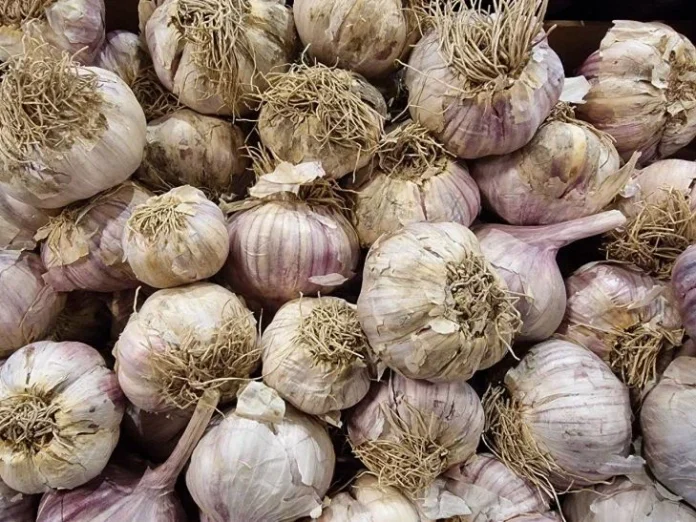Harvesting garlic is an important stage in the gardening season. After the aromatic heads are removed from the ground, the question of restoring soil fertility arises..
The correct choice of fertilizers and approach to cultivating the site will determine the success of future plantings in this place..
Our magazine expert Anastasia Kovrizhnykh – a scientist agronomist, landscape designer, reminded summer residents of the most important thing.
Organic fertilizers
Compost is one of the best options for restoring the soil after garlic.
Adding well-rotted compost enriches the soil with organic matter, improves its structure and promotes the development of beneficial microorganisms.
It is recommended to add 3-5 kg of compost per square meter, evenly distributing it over the surface and burying it in the topsoil.
Manure also effectively restores soil fertility. However, only rotted manure should be used to avoid ‘burning’ the roots of future plants and the spread of weeds. The application rate is 4-6 kg per square meter.
It is better to work manure into the soil to a depth of 10-15 cm.
Green fertilizers
Sowing green manure after harvesting garlic is an excellent way to improve the soil structure and enrich it with nitrogen.
Mustard, phacelia or vetch quickly build up green mass, which is then worked into the soil.
Green manure not only enriches the soil with nutrients, but also suppresses weed growth and prevents the development of pests and diseases.
Mineral fertilizers
Phosphorus-potassium fertilizers are applied in the fall to replenish the elements used up by garlic. Superphosphate (30-40 g/m3) and potassium sulfate (20-25 g/m3) improve the structure of the soil and increase its fertility. These fertilizers can be applied both separately and as part of complex autumn mixtures.
Wood ash
Ash is a valuable source of potassium, phosphorus and microelements. After harvesting garlic, you can add 100-150 g of ash per square meter.
In addition to enriching the soil with nutrients, ash helps deoxidize the soil, which is especially important for areas with high acidity.
Liming the soil
Garlic prefers slightly acidic soils, so liming may be required after harvesting.
Dolomite flour or slaked lime, applied in the fall, will help normalize the soil pH. The application rate depends on the initial acidity and ranges from 300 to 500 g per square meter.
Mulching
Mulching the soil after applying fertilizer helps to retain moisture, prevent weed growth, and protect soil microorganisms.
You can use mown grass, straw, or fallen leaves as mulch. A 5-7 cm thick layer of mulch is evenly distributed over the soil surface.
Crop rotation
It is important to remember to follow crop rotation. It is not recommended to plant onion crops after garlic.
The best predecessors are legumes, pumpkin, or cruciferous crops. Proper plant rotation helps prevent soil depletion and reduces the risk of disease.
Green manure not only enriches the soil with nutrients, but also suppresses weed growth and prevents the development of pests and diseases.
Mineral fertilizers
Phosphorus-potassium fertilizers are applied in the fall to replenish the elements used up by garlic. Superphosphate (30-40 g/m3) and potassium sulfate (20-25 g/m3) improve the structure of the soil and increase its fertility. These fertilizers can be applied both separately and as part of complex autumn mixtures.
Wood ash
Ash is a valuable source of potassium, phosphorus and microelements. After harvesting garlic, you can add 100-150 g of ash per square meter.
In addition to enriching the soil with nutrients, ash helps deoxidize the soil, which is especially important for areas with high acidity.
Liming the soil
Garlic prefers slightly acidic soils, so liming may be required after harvesting.
Dolomite flour or slaked lime, applied in the fall, will help normalize the soil pH. The application rate depends on the initial acidity and ranges from 300 to 500 g per square meter.
Mulching
Mulching the soil after applying fertilizer helps to retain moisture, prevent weed growth, and protect soil microorganisms.
You can use mown grass, straw, or fallen leaves as mulch. A 5-7 cm thick layer of mulch is evenly distributed over the soil surface.
Crop rotation
It is important to remember to follow crop rotation. It is not recommended to plant onion crops after garlic.
The best predecessors are legumes, pumpkin, or cruciferous crops. Proper plant rotation helps prevent soil depletion and reduces the risk of disease.
Green manure not only enriches the soil with nutrients, but also suppresses weed growth and prevents the development of pests and diseases.
Mineral fertilizers
Phosphorus-potassium fertilizers are applied in the fall to replenish the elements used up by garlic. Superphosphate (30-40 g/m3) and potassium sulfate (20-25 g/m3) improve the structure of the soil and increase its fertility. These fertilizers can be applied both separately and as part of complex autumn mixtures.
Wood ash
Ash is a valuable source of potassium, phosphorus and microelements. After harvesting garlic, you can add 100-150 g of ash per square meter.
In addition to enriching the soil with nutrients, ash helps deoxidize the soil, which is especially important for areas with high acidity.
Liming the soil
Garlic prefers slightly acidic soils, so liming may be required after harvesting.
Dolomite flour or slaked lime, applied in the fall, will help normalize the soil pH. The application rate depends on the initial acidity and ranges from 300 to 500 g per square meter.
Mulching
Mulching the soil after applying fertilizer helps to retain moisture, prevent weed growth, and protect soil microorganisms.
Mown grass, straw, or fallen leaves can be used as mulch. A 5-7 cm thick layer of mulch is evenly distributed over the soil surface.
Crop rotation
It is important to remember to observe crop rotation. After garlic, it is not recommended to plant crops of the onion family.
The best predecessors will be legumes, pumpkin or cruciferous crops. Proper plant rotation helps prevent soil depletion and reduces the risk of disease.


